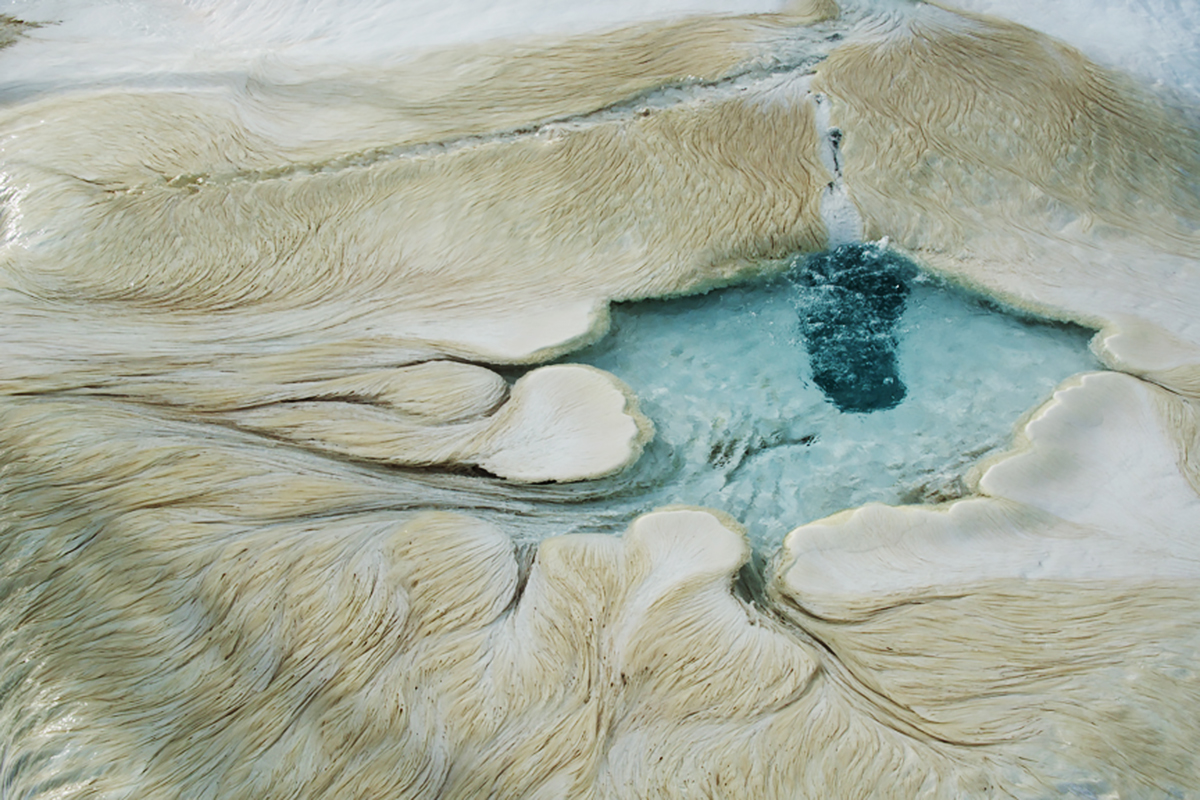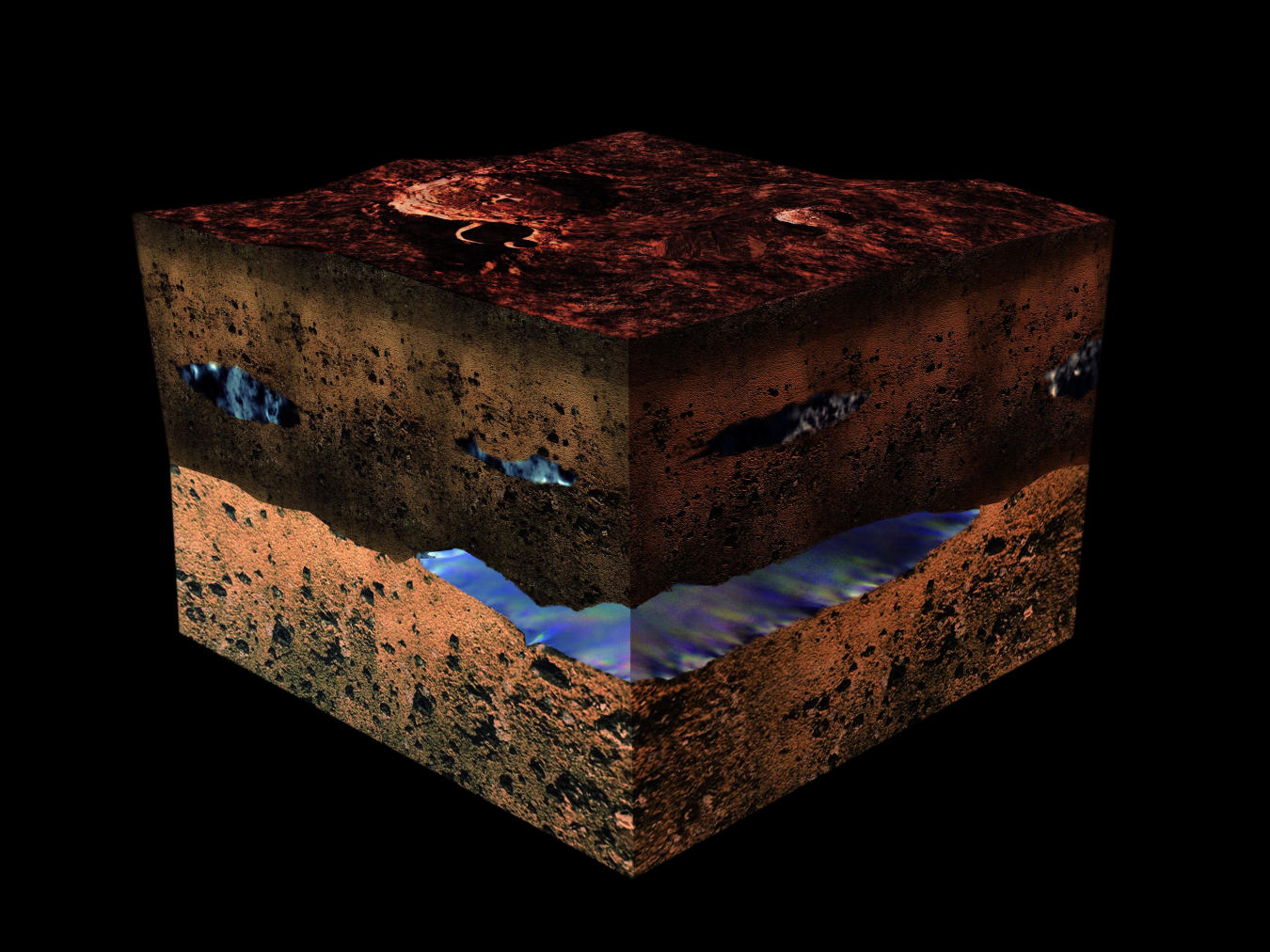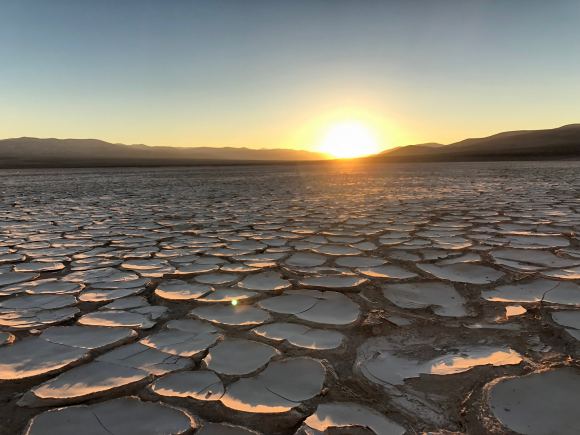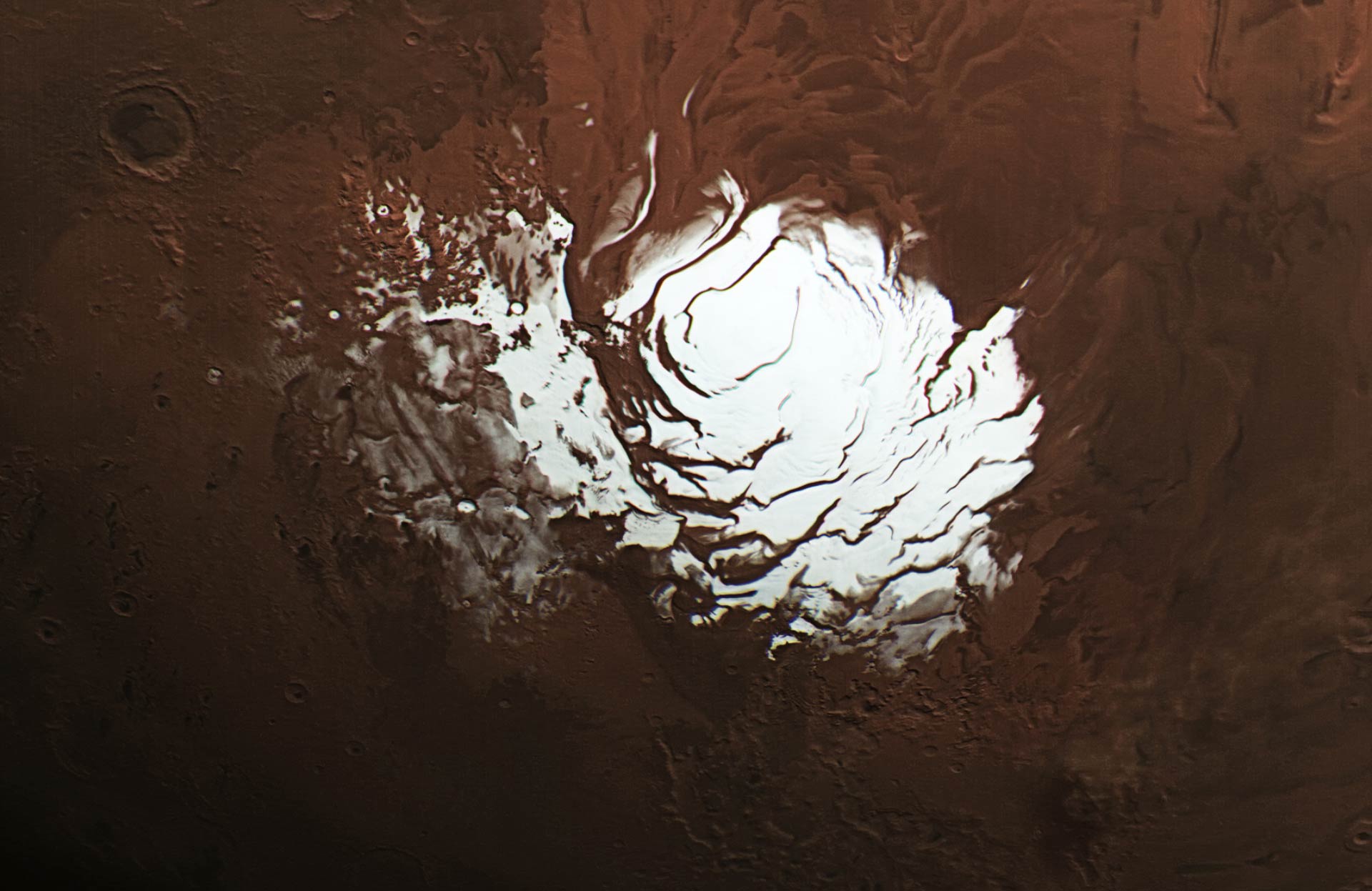According to a new NASA-funded study that appeared in Astrobiology, the next missions to Mars should be on the lookout for rocks that look like “fettuccine”. The reason for this, according to the research team, is that the formation of these types of rocks is controlled by a form of ancient and hardy bacteria here on Earth that are able to thrive in conditions similar to what Mars experiences today.
Continue reading “Rovers on Mars should be searching for rocks that look like pasta – they’re almost certainly created by life”Planetary Scientists Have Chosen a Few Landing Sites for the Mars 2020 Rover
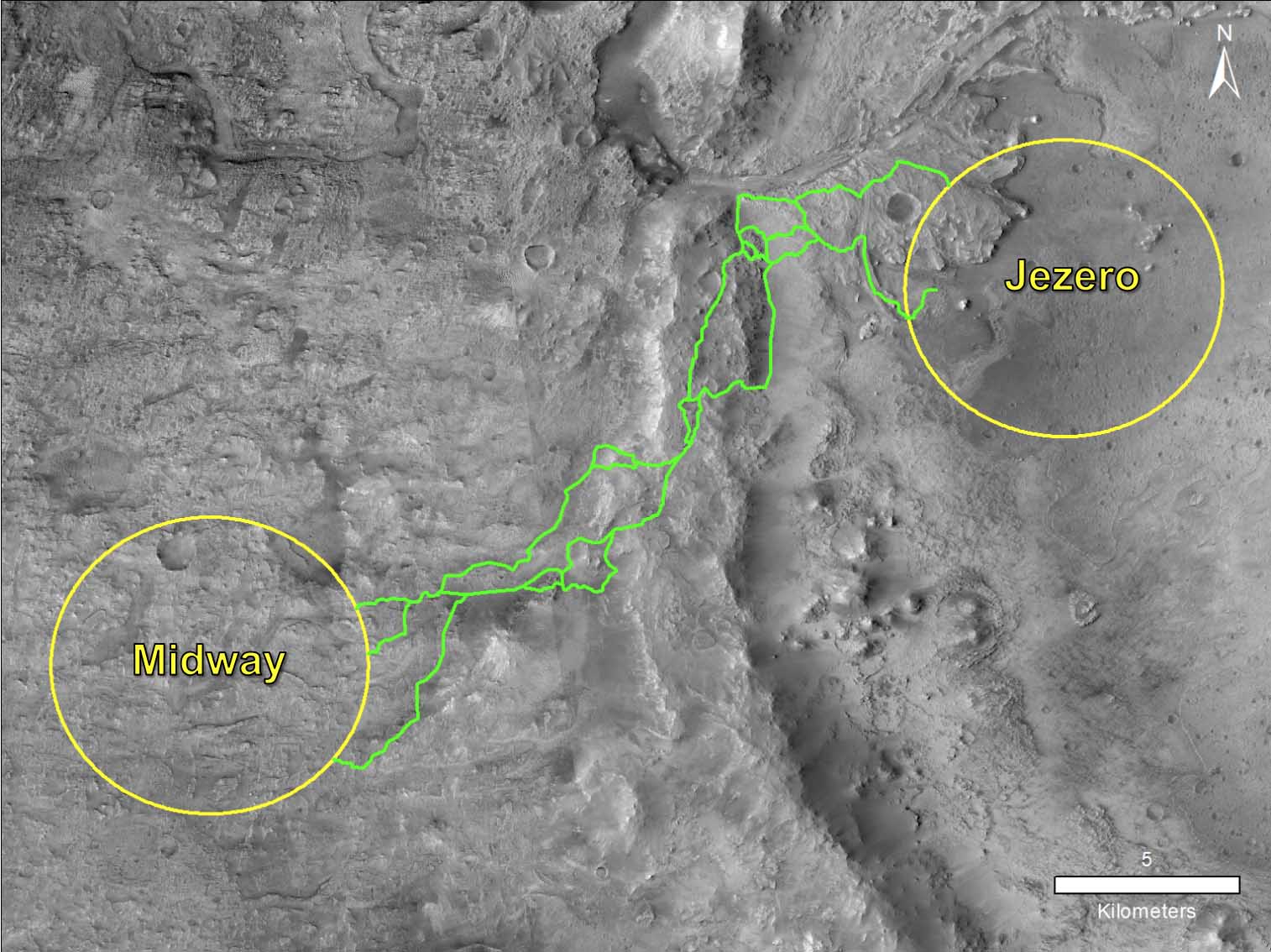
In the summer of 2020, NASA’s Mars 2020 rover will launch from Cape Canaveral and commence its journey towards the Red Planet. Once it arrives on the Martian surface, the rover will begin building on the foundation established by the Opportunity and Curiosity rovers. This will include collecting samples of Martian soil to learn more about the planet’s past and determine if life ever existed there (and still does).
Up until now, though, NASA has been uncertain as to where the rover will be landing. For the past few years, the choice has been narrowed down to three approved sites, with a fourth added earlier this year for good measure. And after three days of intense debate at the recent fourth Landing Site Workshop, scientists from NASA’s Mars Exploration Program held a non-binding vote that has brought them closer to selecting a landing site.
Continue reading “Planetary Scientists Have Chosen a Few Landing Sites for the Mars 2020 Rover”
There Might be Enough Oxygen Below the Surface of Mars to Support Life
The possibility that life could exist on Mars has captured the imagination of researchers, scientists and writers for over a century. Ever since Giovanni Schiaparelli (and later, Percival Lowell) spotted what they believed were “Martian Canals” in the 19th century, humans have dreamed of one day sending emissaries to the Red Planet in the hopes of finding a civilization and meeting the native Martians.
While the Mariner and Viking programs of the 1960s and 70s shattered the notion of a Martian civilization, multiple lines of evidence have since emerged that indicate how life could have once existed on Mars. Thanks to a new study, which indicates that Mars may have enough oxygen gas locked away beneath its surface to support aerobic organisms, the theory that life could still exist there has been given another boost.
Continue reading “There Might be Enough Oxygen Below the Surface of Mars to Support Life”
Was This Huge River Delta on Mars the Place Where its Oceans Finally Disappeared?
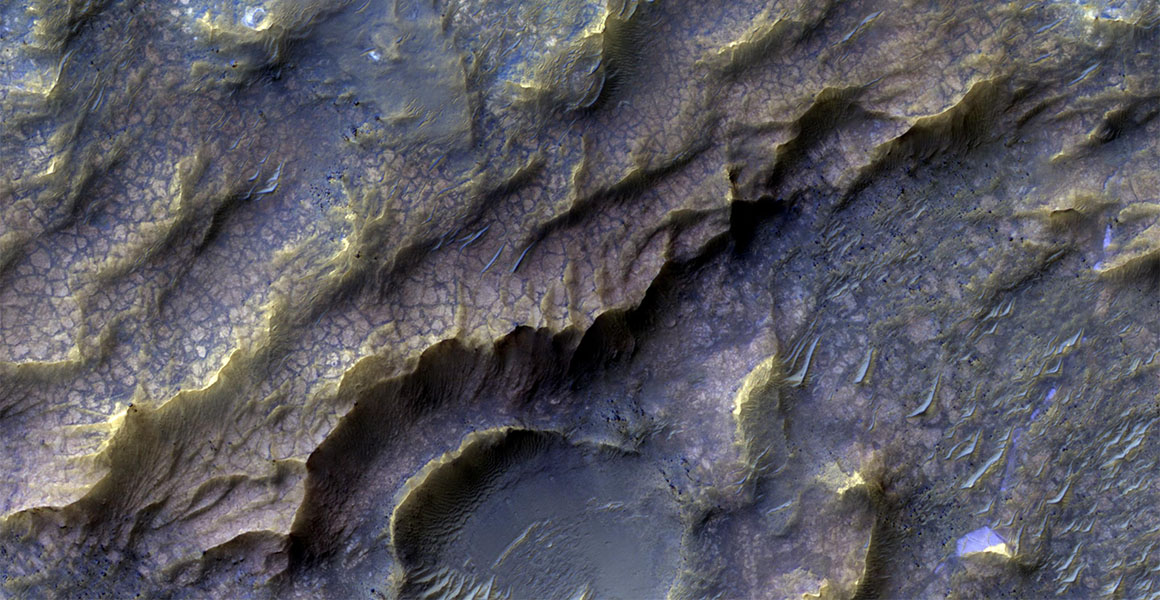
For some time, scientists have known that Mars was once a much warmer and wetter environment than it is today. However, between 4.2 and 3.7 billion years ago, its atmosphere was slowly stripped away, which turned the surface into the cold and desiccated place we know today. Even after multiple missions have confirmed the presence of ancient lake beds and rivers, there are still unanswered questions about how much water Mars once had.
One of the most important unanswered questions is whether or not large seas or an ocean ever existed in the northern lowlands. According to a new study by an international team of scientists, the Hypanis Valles ancient river system is actually the remains of a river delta. The presence of this geological feature is an indication that this river system once emptied into an ancient Martian sea in Mars’ northern hemisphere.
Continue reading “Was This Huge River Delta on Mars the Place Where its Oceans Finally Disappeared?”
Mars is 1000x Drier Than the Driest Places on Earth

For generations, many have dreamed about the day when it would be possible to set foot on Mars – aka. “Earth’s Twin” planet. And in the past few years, multiple orbiters, landers and rovers have revealed evidence of past water on Mars, not to mention the possibility that water still exists underground. These findings have fueled the desire to send crewed missions to Mars, not to mention proposals to establish a colony there.
However, this enthusiasm may seem a little misguided when you consider all the challenges the Martian environment presents. In addition to it being very cold and subject to a lot of radiation, the surface of Mars today is also extremely dry. According to a new study led by researchers from NASA’s Ames Research Center, Martian soil is roughly 1000 times drier than some of the driest regions on Earth.
The study, titled “Constraints on the Metabolic Activity of Microorganisms in Atacama Surface Soils Inferred from Refractory Biomarkers: Implications for Martian Habitability and Biomarker Detection“, recently appeared in the journal Astrobiology. The study was led by members from NASA Ames Research Center and included researchers from the Georgia Institute of Technology, the Carl Sagan Center at the SETI Institute, the Centro de Astrobiologia (INTA-CSIC), the NASA Goddard Space Flight Center, and the Massachusetts Institute of Technology.
For the sake of their study, the research team sought to determine if microorganisms can survive under the types of conditions present on Mars. To answer this question, the team traveled to the the Atacama Desert in Chile, a 1000 km (620 mi) strip of land on South America’s west coast. With an average rainfall of just 1 to 3 mm (0.04 to 0.12 in) a year, the Atacama desert is known as the driest nonpolar place in the world.
However, the Atacama desert is not uniformly dry, and experiences different levels of precipitation depending on the latitude. From the southern end to the northern end, annual precipitation shifts from a few millimeters of rain per year to only a few millimeters of rain per decade. This environment provides an opportunity to search for life at decreasing levels of precipitation, thus allowing researchers to place constraints on microorganism survivability.
It is at the northern end of the desert (in what is known as the Antofagasta region) where conditions become most Mars-like. Here, the average annual rainfall is just 1 mm a year, which has made it a popular destination for scientists looking to simulate a Martian environment. In addition to seeing if microbes could survive in these dry conditions, the team also sought to determine if they were capable of growth and reproduction.
As Mary Beth Wilhelm – an astrobiologist at the Georgia Institute of Technology, NASA’s Ames Research Center, and lead author of the new study – explained in a recent NASA press release:
“On Earth, we find evidence of microbial life everywhere. However, in extreme environments, it’s important to know whether a microbe is dormant and just barely surviving, or really alive and well… By learning if and how microbes stay alive in extremely dry regions on Earth, we hope to better understand if Mars once had microbial life and whether it could have survived until today.”
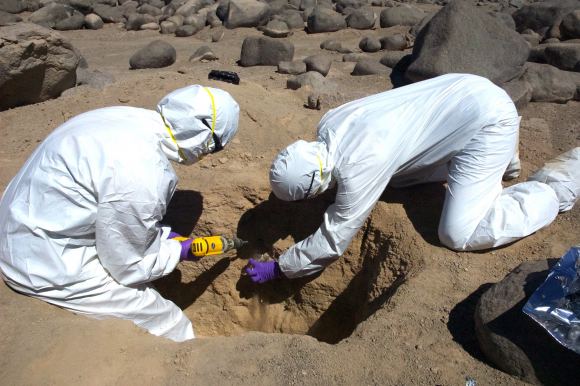
After collecting soil samples from across the Atacama Desert and brought them back to their lab at Ames, the research team began performing tests to see if their microorganism samples showed any indication of stress markers. These are a key way in which life can be shown to be growing, since organisms in a dormant state (i.e. that are just surviving) show no signs of stress markers.
Specifically, they looked for changes in the lipid structure of the cells outer membranes, which typically become more rigid in response to stress. What they found was that in the less dry parts of the Atacama Desert, this stress marker was present; but strangely, these same markers were missing in the driest regions of the desert where microbes would be more stressed.
Based on these and other results, the team concluded that there is a transition line for microorganisms in environments like the Atacama Desert. On one side of this line, the presence of minute amounts of water is enough for organisms to still be able to grow. On the other side, the environment is so dry that organisms can survive but will not grow and reproduce.
The team was also able to find evidence of microbes that had been dead in the Atacama soil samples for at least 10,000 years. They were able to determine this by examining the amino acids of the microbes, which are the building blocks of proteins, and examining the rate at which their structure changed. This find was rather surprising, seeing as how it is extremely rare that the remnant of ancient life be found on the surface of Earth.
Given that Mars is 1,000 times drier than even the driest parts of Atacama, these results were not encouraging news for those hoping that microbial life will still be found there. However, the fact that the remnants of past microbial life were found in the driest areas of Chile’s desert – which would have existed when conditions were wetter and were well-preserved – is very good news when it comes to the search for past life on Mars.
Essentially, if microbial life did exist on Mars back when it was a warmer, wetter environment, traces of that ancient life might still exist. As Wilhelm explained:
“Before we go to Mars, we can use the Atacama like a natural laboratory and, based on our results, adjust our expectations for what we might find when we get there. Knowing the surface of Mars today might be too dry for life to grow, but that traces of microbes can last for thousands of years helps us design better instruments to not only search for life on and under the planet’s surface, but to try and unlock the secrets of its distant past.”
In the future, missions like NASA’s Mars 2020 rover will be seeking to procure samples of Martian soil. If NASA’s proposed “Journey to Mars” takes place by the 2030s as planned, these samples could then be returned to Earth for analysis. With luck, these soil samples will reveal evidence of past life and prove that Mars was once a habitable planet!
Further Reading: NASA
Underground Liquid Water Found on Mars!
According to evidence gathered by multiple robotic orbiters, rovers, and landers over the course of several decades, scientists understand that Mars was once a warmer, watery place. But between 4.2 and 3.7 billion years ago, this began to change. As Mars magnetic field disappeared, the atmosphere slowly began to be stripped away by solar wind, leaving the surface the cold and dry and making it impossible for water to exist in liquid form.
While much of the planet’s water is now concentrated in the polar ice caps, scientists have speculated some of Mars’ past water could still be located underground. Thanks to a new study by a team of Italian scientists, it has now been confirmed that liquid water still exists beneath Mars’ southern polar region. This discovery has put an end to a fifteen-year mystery and bolstered the potential for future missions to Mars.
The study, titled “Radar evidence of subglacial liquid water on Mars“, recently appeared in the journal Science. The study was led by Roberto Orosei of the National Institute of Astrophysics (INAF) in Italy, and included members from the Italian Space Agency (ASI), the ESA Center for Earth Observation (ESRIN), and multiple observatories, research institutions and universities.

So far, robotic missions have revealed considerable evidence of past water on Mars. These include dried-out river valleys and gigantic outflow channels discovered by orbiters, and evidence of mineral-rich soils that can only form in the presence of liquid water by rovers and landers. Early evidence from the ESA’s Mars Express probe has also showed that water-ice exists at the planet’s poles and is buried in the layers interspersed with dust.
However, scientists have long suspected that liquid water could exist beneath the polar ice caps, much in the same way that liquid water is believed to underlie glaciers here on Earth. In addition, the presence of salts on Mars could further reduce the melting point of subsurface water and keep it in a liquid state, despite the sub-zero temperatures present on both the surface and underground.
For many years, data from the Mars Express’ Mars Advanced Radar for Subsurface and Ionosphere Sounding (MARSIS) instrument – which has been used to study the southern polar region – has remained inconclusive. Like all ground-penetrating radar, this instrument relies on radar pulses to map surface topography and determine the properties of the materials that lie beneath the surface.
Luckily, after considerable analysis, the study team was able to develop new techniques that allowed them to collect enough high-resolution data to confirm the presence of liquid water beneath the southern ice cap. As Andrea Cicchetti, the MARSIS operations manager and a co-author on the new paper, indicated:
“We’d seen hints of interesting subsurface features for years but we couldn’t reproduce the result from orbit to orbit, because the sampling rates and resolution of our data was previously too low. We had to come up with a new operating mode to bypass some onboard processing and trigger a higher sampling rate and thus improve the resolution of the footprint of our dataset: now we see things that simply were not possible before.”
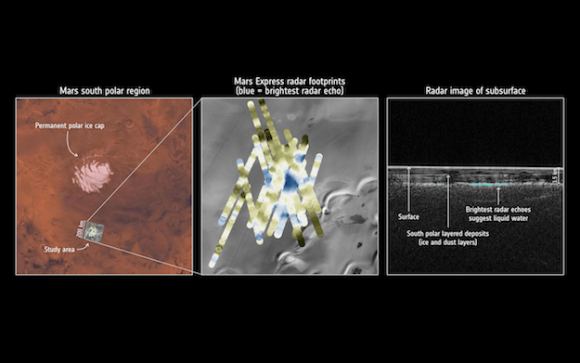
What they found was that the southern polar region is made of many layers of ice and dust down to a depth of about 1.5 km over a 200 km-wide area, and featured an anomalous area measuring 20-km wide. As Roberto Orosei, the principal investigator of the MARSIS experiment and lead author of the paper, explained in a recent ESA press release:
“This subsurface anomaly on Mars has radar properties matching water or water-rich sediments. This is just one small study area; it is an exciting prospect to think there could be more of these underground pockets of water elsewhere, yet to be discovered.”
After analyzing the properties of the reflected radar signals and taking into account the composition of the layered deposits and expected temperature profiles below the surface, the scientists concluded that the 20-km wide feature is an interface between the ice and a stable body of liquid water. For MARSIS to be able to detect such a patch of water, it would need to be at least several tens of centimeters thick.
These findings also raise the possibility of there being life on Mars, both now and in the past. This is based on research that found microbial life in Lake Vostok, which is located some 4 km (2.5 mi) below the ice in Antarctica. If life can thrive in salty, subglacial environments on Earth, then it is possible that they could survive on Mars as well. Determining if this is the case will be the purpose of existing and future missions to Mars.
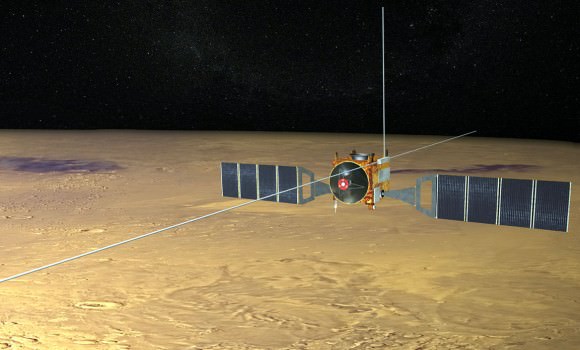
As Dmitri Titov, one of the Mars Express project scientist, explained:
“The long duration of Mars Express, and the exhausting effort made by the radar team to overcome many analytical challenges, enabled this much-awaited result, demonstrating that the mission and its payload still have a great science potential. This thrilling discovery is a highlight for planetary science and will contribute to our understanding of the evolution of Mars, the history of water on our neighbour planet and its habitability.”
The Mars Express launched on June 2nd, 2003, and will celebrate 15 years in orbit of Mars by December 25th this year. In the coming years, it will be joined by the ESA’s ExoMars 2020 mission, NASA’s Mars 2020 Rover, and a number of other scientific experiments. These missions will pave the way for a potential crewed mission, which NASA is planning to mount by the 2030s.
If there is indeed liquid water to be found on Mars, it will go a long way towards facilitating future research and even an ongoing human presence on the surface. And if there is still life on Mars, the careful research of its ecosystems will help address the all-important question of how and when life emerged in the Solar System.
New Research Raises Hopes for Finding Life on Mars, Pluto and Icy Moons
Since the 1970s, when the Voyager probes captured images of Europa’s icy surface, scientists have suspected that life could exist in interior oceans of moons in the outer Solar System. Since then, other evidence has emerged that has bolstered this theory, ranging from icy plumes on Europa and Enceladus, interior models of hydrothermal activity, and even the groundbreaking discovery of complex organic molecules in Enceladus’ plumes.
However, in some locations in the outer Solar System, conditions are very cold and water is only able to exist in liquid form because of the presence of toxic antifreeze chemicals. However, according to a new study by an international team of researchers, it is possible that bacteria could survive in these briny environments. This is good news for those hoping to find evidence of life in extreme environments of the Solar System.
The study which details their findings, titled “Enhanced Microbial Survivability in Subzero Brines“, recently appeared in the scientific journal Astrobiology. The study was conducted by Jacob Heinz from the Center of Astronomy and Astrophysics at the Technical University of Berlin (TUB), and included members from Tufts University, Imperial College London, and Washington State University.
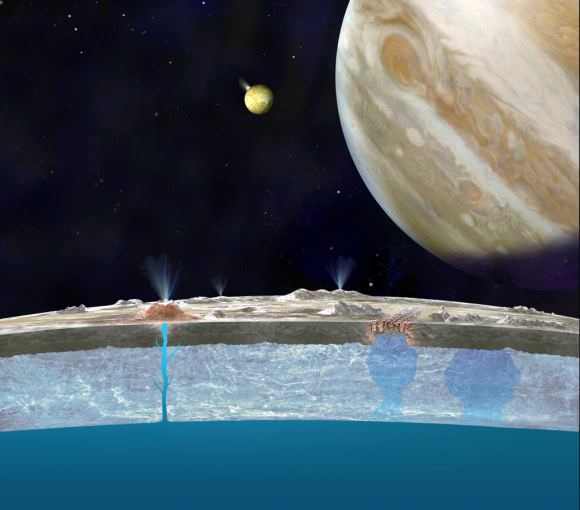
Basically, on bodies like Ceres, Callisto, Triton, and Pluto – which are either far from the Sun or do not have interior heating mechanisms – interior oceans are believed to exist because of the presence of certain chemicals and salts (such as ammonia). These “antifreeze” compounds ensure that their oceans have lower freezing points, but create an environment that would be too cold and toxic to life as we know it.
For the sake of their study, the team sought to determine if microbes could indeed survive in these environments by conducting tests with Planococcus halocryophilus, a bacteria found in the Arctic permafrost. They then subjected this bacteria to solutions of sodium, magnesium and calcium chloride as well as perchlorate, a chemical compound that was found by the Phoenix lander on Mars.
They then subjected the solutions to temperatures ranging from +25°C to -30°C through multiple freeze and thaw cycles. What they found was that the bacteria’s survival rates depended on the solution and temperatures involved. For instance, bacteria suspended in chloride-containing (saline) samples had better chances of survival compared to those in perchlorate-containing samples – though survival rates increased the more the temperatures were lowered.
For instance, the team found that bacteria in a sodium chloride (NaCl) solution died within two weeks at room temperature. But when temperatures were lowered to 4 °C (39 °F), survivability began to increase and almost all the bacteria survived by the time temperatures reached -15 °C (5 °F). Meanwhile, bacteria in the magnesium and calcium-chloride solutions had high survival rates at –30 °C (-22 °F).
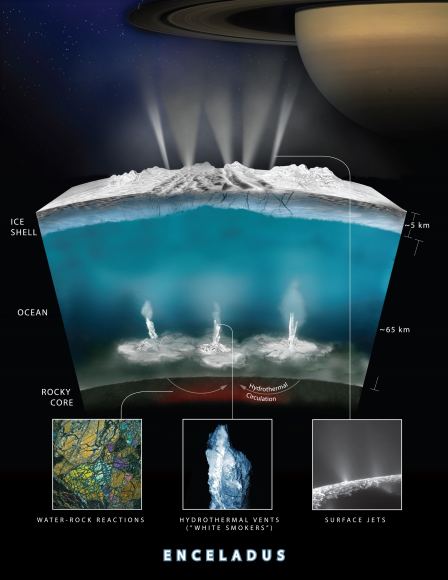
The results also varied for the three saline solvents depending on the temperature. Bacteria in calcium chloride (CaCl2) had significantly lower survival rates than those in sodium chloride (NaCl) and magnesium chloride (MgCl2)between 4 and 25 °C (39 and 77 °F), but lower temperatures boosted survival in all three. The survival rates in perchlorate solution were far lower than in other solutions.
However, this was generally in solutions where perchlorate constituted 50% of the mass of the total solution (which was necessary for the water to remain liquid at lower temperatures), which would be significantly toxic. At concentrations of 10%, bacteria was still able to grow. This is semi-good news for Mars, where the soil contains less than one weight percent of perchlorate.
However, Heinz also pointed out that salt concentrations in soil are different than those in a solution. Still, this could be still be good news where Mars is concerned, since temperatures and precipitation levels there are very similar to parts of Earth – the Atacama Desert and parts of Antarctica. The fact that bacteria have can survive such environments on Earth indicates they could survive on Mars too.
In general, the research indicated that colder temperatures boost microbial survivability, but this depends on the type of microbe and the composition of the chemical solution. As Heinz told Astrobiology Magazine:
“[A]ll reactions, including those that kill cells, are slower at lower temperatures, but bacterial survivability didn’t increase much at lower temperatures in the perchlorate solution, whereas lower temperatures in calcium chloride solutions yielded a marked increase in survivability.”
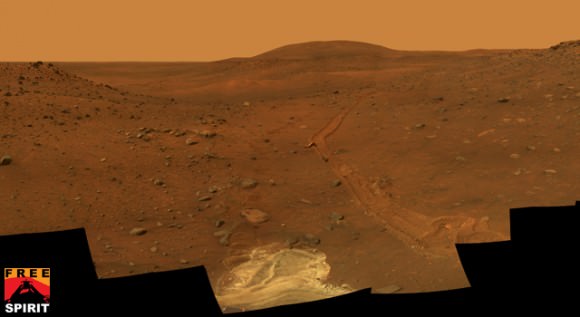
The team also found that bacteria did better in saltier solutions when it came to freezing and thawing cycles. In the end, the results indicate that survivability all comes down to a careful balance. Whereas lower concentrations of chemical salts meant that bacteria could survive and even grow, the temperatures at which water would remain in a liquid state would be reduced. It also indicated that salty solutions improve bacteria survival rates when it comes to freezing and thawing cycles.
Of course, the team emphasized that just because bacteria can subsist in certain conditions doesn’t mean they will thrive there. As Theresa Fisher, a PhD student at Arizona State University’s School of Earth and Space Exploration and a co-author on the study, explained:
“Survival versus growth is a really important distinction, but life still manages to surprise us. Some bacteria can not only survive in low temperatures, but require them to metabolize and thrive. We should try to be unbiased in assuming what’s necessary for an organism to thrive, not just survive.”
As such, Heinz and his colleagues are currently working on another study to determine how different concentrations of salts across different temperatures affect bacterial propagation. In the meantime, this study and other like it are able to provide some unique insight into the possibilities for extraterrestrial life by placing constraints on the kinds of conditions that they can survive and grow in.
These studies also allow help when it comes to the search for extraterrestrial life, since knowing where life can exist allows us to focus our search efforts. In the coming years, missions to Europa, Enceladus, Titan and other locations in the Solar System will be looking for biosignatures that indicate the presence of life on or within these bodies. Knowing that life can survive in cold, briny environments opens up additional possibilities.
Further Reading: Astrobiology Magazine, Astrobiology
And NASA’s Big Announcement is: Ancient Organic Molecules Found on Mars!

Ever since Curiosity landed on Mars in 2012, the rover has made numerous groundbreaking discoveries about the Red Planet. These include confirming how Mars once had flowing water and lakes on its surface, evidence of how it lost its ancient atmosphere, and the discovery of methane and organic molecules. All of these discoveries have bolstered the theory that Mars may have once supported life.
The latest discovery came on Thursday, May 7th, when NASA announced that the Curiosity rover had once again discovered organic molecules. This time, however, the molecules were found in three-billion-year-old sedimentary rocks located near the surface of lower Mount Sharp. This evidence, along with new atmospheric evidence, are another indication that ancient life may have once existed on the Red Planet.
The new findings appear in two new studies – titled “Organic matter preserved in 3-billion-year-old mudstones at Gale crater, Mars” and “Background levels of methane in Mars’ atmosphere show strong seasonal variations” – that were published in the June 8th issue of Science. As these studies indicate, these molecules – while not evidence of life in and of itself – have bolstered the search for evidence of past life.
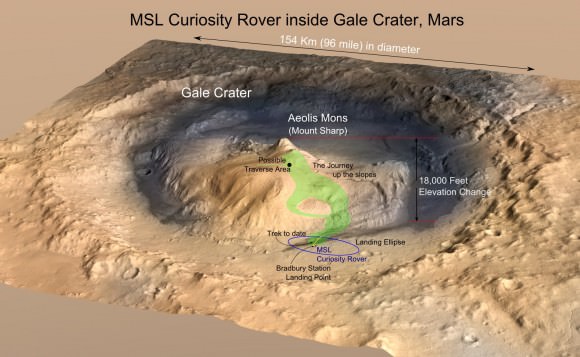
As Thomas Zurbuchen, the associate administrator for the Science Mission Directorate at NASA Headquarters, explained in a recent NASA press release:
“With these new findings, Mars is telling us to stay the course and keep searching for evidence of life. I’m confident that our ongoing and planned missions will unlock even more breathtaking discoveries on the Red Planet.”
In the first paper, the authors indicate how Curiosity’s Sample Analysis at Mars (SAM) suite detected traces of methane in drill samples it took from Martian rocks. Once these rocks were heated, they released an array of organics and volatiles similar to how organic-rich sedimentary rocks do on Earth. On Earth, such deposits are indications of fossilized organic life, which may or may not be the case with the samples examined by Curiosity.
However, this evidence is bolstered by the fact that Curiosity has also found evidence that the Gale Crater was once an ancient lakebed. In addition to water, this lakebed contained all the chemical building blocks and energy sources that are necessary for life. As Jen Eigenbrode of NASA’s Goddard Space Flight Center, and the lead author of the first study, explained:
“Curiosity has not determined the source of the organic molecules. Whether it holds a record of ancient life, was food for life, or has existed in the absence of life, organic matter in materials holds chemical clues to planetary conditions and processes… The Martian surface is exposed to radiation from space. Both radiation and harsh chemicals break down organic matter. Finding ancient organic molecules in the top five centimeters of rock that was deposited when Mars may have been habitable, bodes well for us to learn the story of organic molecules on Mars with future missions that will drill deeper.”
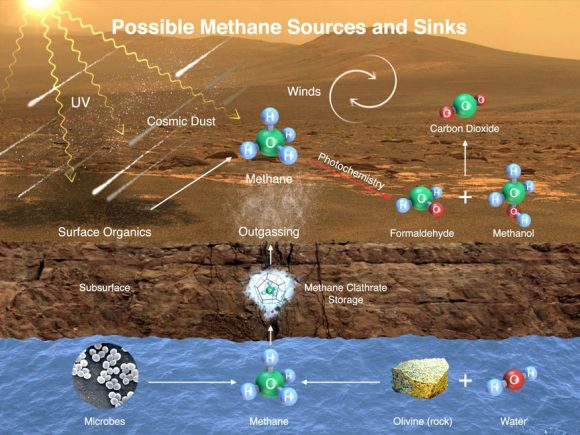
In the second paper, the team described how Curiosity’s SAM suite also detected seasonal variations in methane in the Martian atmosphere. These results were obtained over the course of nearly three years on Mars, which works out to almost six Earth years. While the team admits that water-rock chemistry could have generated the methane, they cannot rule out the possibility that it was biological in origin.
In the past, methane and organic molecules have been detected in Mars’ atmosphere and in drill samples, the former of which appeared to spike unpredictably. However, these new results indicate that within the Gale Crater, low levels of methane peak during the warm summer months and drop in the winter months every year. As Chris Webster, a researcher from NASA’s Jet Propulsion Laboratory (JPL) and the lead author of the second paper, explained:
“This is the first time we’ve seen something repeatable in the methane story, so it offers us a handle in understanding it. This is all possible because of Curiosity’s longevity. The long duration has allowed us to see the patterns in this seasonal ‘breathing.'”
To find this organic material, Curiosity drilled into sedimentary rocks (known as mudstone) in four areas in the Gale Crater. These rocks formed over the course of billions of years as sediments were deposited at the bottom of the ancient lake by flowing water. The drill samples were then analyzed by SAM, which used its oven to heat the samples to over 500 °C (900 °F) to release organic molecules from the powdered rock.
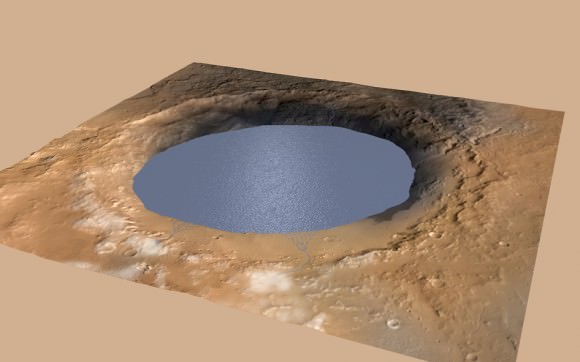
These results indicate that some of the drill samples contained sulfur (which could have preserved the organic molecules) as well as thiophenes, benzene, toluene, and small carbon chains – such as propane or butene. They also indicated organic carbon concentrations of about 10 parts per million or more, which is consistent with carbon concentrations observed in Martian meteorites and about 100 times what has been previously detected on Mars’ surface.
While this does not constitute evidence of past life on Mars, these latest findings have increased confidence that future missions will find more organics, both on the surface and slightly beneath the surface. But above all, they have bolstered confidence that Mars may have once had life of its own. As Michael Meyer, the lead scientist for NASA’s Mars Exploration Program, summarized:
“Are there signs of life on Mars? We don’t know, but these results tell us we are on the right track.”
In the coming years, additional missions will also be searching for signs of past life, including NASA’s Mars 2020 rover and the European Space Agency’s ExoMars rover.The Mars 2020 rover will also leave samples behind in a cache that could be retrieved by a future crewed mission for sample-return analysis. So if there was life on Mars (or, fingers crossed, still is) we are sure to find it soon enough!
And be sure to check out this video of this latest discovery by Curiosity, courtesy of NASA’s Jet Propulsion Laboratory:
Further Reading: NASA
NASA is Sending a Helicopter to Mars as Part of the 2020 Rover
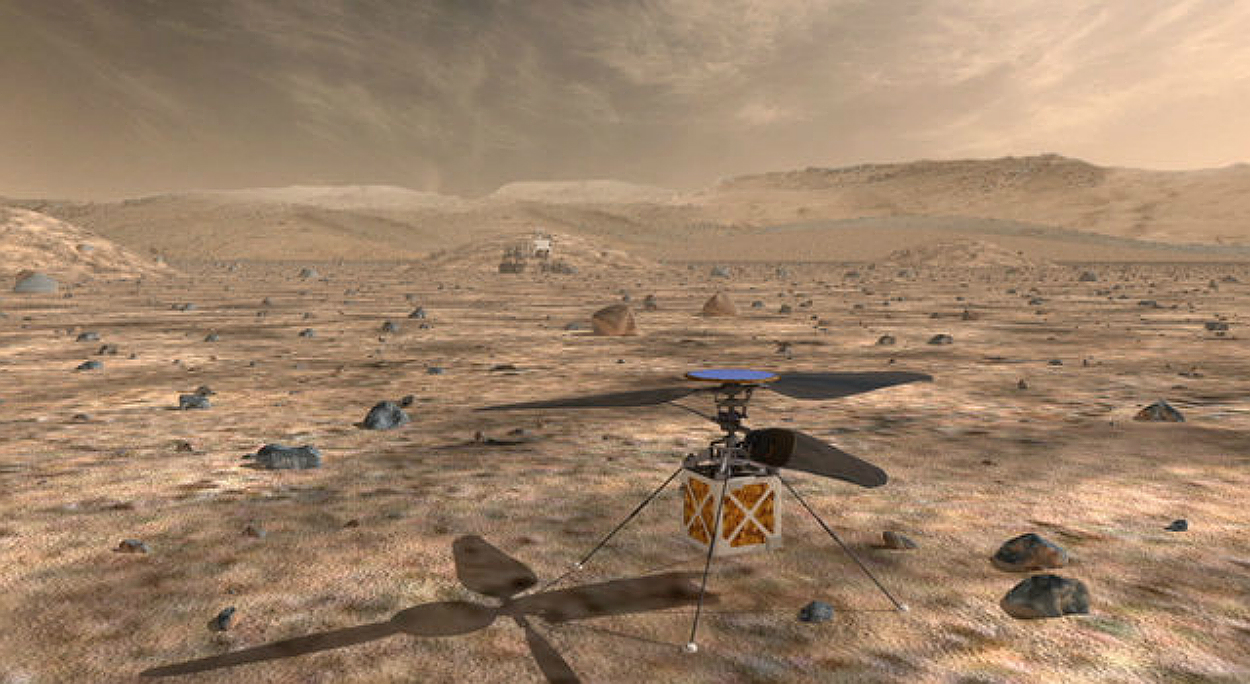
At present, there are over a dozen robotic missions exploring the atmosphere and surface of Mars. These include, among others, the Curiosity rover, the Opportunity rover, the Mars Orbiter Mission (MOM), the Mars Reconnaissance Orbiter (MRO), the Mars Atmosphere and Volatile EvolutioN (MAVEN) orbiter, and the soon-to-arrive InSight Lander. In the coming decade, many more missions are planned.
For instance, NASA plans to expand on what Curiosity has accomplished by sending the Mars 2020 rover to conduct a sample-return mission. According to a recent announcement issued by NASA, this mission will also include the Mars Helicopter – a small, autonomous rotorcraft that will demonstrate the viability and potential of heavier-than-air vehicles on the Red Planet.
As NASA Administrator Jim Bridenstine declared in a recent NASA press release, this rotocraft is in keeping with NASA’s long-standing traditions of innovation. “NASA has a proud history of firsts,” she said. “The idea of a helicopter flying the skies of another planet is thrilling. The Mars Helicopter holds much promise for our future science, discovery, and exploration missions to Mars.”

U.S. Rep. John Culberson of Texas echoed Bridenstine statement. “It’s fitting that the United States of America is the first nation in history to fly the first heavier-than-air craft on another world,” he said. “This exciting and visionary achievement will inspire young people all over the United States to become scientists and engineers, paving the way for even greater discoveries in the future.”
The Mars Helicopter began as technology development project at NASA’s Jet Propulsion Laboratory (JPL), where it spent the past four years being designed, developed, tested and retested. The result of this is a football-sized rotorcraft that weights just under 1.8 kg (four pounds) and relies on two counter-rotating blades to spin at a rate of almost 3,000 rpm (10 times the rate of a helicopter here on Earth).
As Mimi Aung, the Mars Helicopter project manager at JPL, indicated:
“The altitude record for a helicopter flying here on Earth is about 40,000 feet. The atmosphere of Mars is only one percent that of Earth, so when our helicopter is on the Martian surface, it’s already at the Earth equivalent of 100,000 feet up. To make it fly at that low atmospheric density, we had to scrutinize everything, make it as light as possible while being as strong and as powerful as it can possibly be.”

This concept is ideal for navigating through Mars’ thin atmosphere, where the mean surface pressure is about 0.6% that of Earth’s at sea level (0.60 kPa compared to 101.3 kPa). This low-flying helicopter would not only be able to increase the range of a rover, it will be able to explore areas that the rover would find inaccessible. As Thomas Zurbuchen, the Associate Administrator for NASA’s Science Mission Directorate, explained:
“Exploring the Red Planet with NASA’s Mars Helicopter exemplifies a successful marriage of science and technology innovation and is a unique opportunity to advance Mars exploration for the future. After the Wright Brothers proved 117 years ago that powered, sustained, and controlled flight was possible here on Earth, another group of American pioneers may prove the same can be done on another world.”
Other capabilities that make it optimized for Mars exploration include lithium-ion batteries, solar cells to keep them charged, and heating mechanisms that will keep it warm during Martian nights – where average temperatures can get as low as 210 K (-63 °C; -82 °F) around the mid-latitudes. In addition, the helicopter is programmed to fly autonomously, since it cannot be flown in real-time (given the distances involved).
Commands will be issued from controllers on Earth, using the rover as a relay, who will instruct the helicopter to commence flight once it is ready to deploy. This will begin shortly after the rover arrives on the planet (which is expected to happen by February 2021) with the helicopter attached to its belly pan. The rover will then select a location to deploy the helicopter onto the ground.
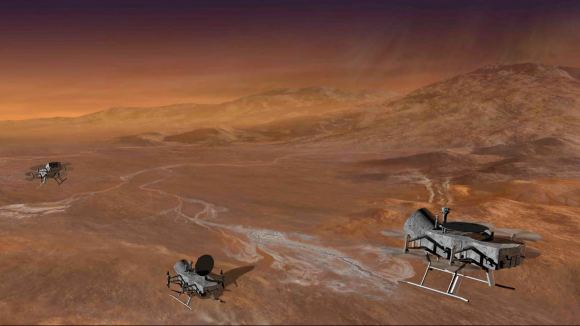
After it is finished charging its batteries and a series of pre-flight tests are performed, controllers on Earth will relay commands to the Mars Helicopter to commence its first 30-day flight test campaign. This will include up to five flights that will take it to increasingly greater distances from the rover (up to a few hundred meters) for longer periods of time (up to 90 seconds).
On its first flight, the helicopter will make a short vertical climb to 3 meters (10 feet) where it will hover for about 30 seconds. Once these tests are complete, the Mars Helicopter will assist the rover as it conducts geological assessments and determines the habitability of its landing sight. The purpose of this will be to search for signs of ancient life on Mars and assesses the natural resources and hazards for future missions involving human explorers.
The rover will also conduct the first-ever sample-return mission from Mars, obtaining samples of rock and soil, encasing them in sealed tubes, and leaving them on the planet for future retrieval by astronauts. If all goes well, the helicopter will demonstrate that low-flying scouts and aerial vehicles can be a valuable part of any future missions. These will likely include robotic missions to Saturn’s largest moon, Titan, where researchers are hoping to explore the surface and atmosphere using helicopter (such as the Dragonfly concept).
The Mars 2020 mission is expected to reveal some very impressive things about the Red Planet. If the helicopter proves to be a viable part of the mission, we can expect that additional information and images will be provided from locations that a conventional rover cannot go. And in the meantime, be sure to enjoy this animation of the Mars Helicopter in action, courtesy of NASA-JPL:
Further Reading: NASA
ExoMars Has Sent Back its First Images From Mars
On October 19th, 2016, the European Space Agency’s Exobiology on Mars (ExoMars) mission established orbit around Mars. Consisting of the ExoMars Trace Gas Orbiter (TGO) and the Schiaparelli lander, the purpose of this mission is to investigate Mars for past signs of life. And whereas the Schiaparelli unfortunately crashed during deployment, the TGO has managed to begin its mission ahead of schedule.
A few weeks ago, the satellite achieved a near circular orbit around Mars after performing a series of braking maneuvers. Since that time, the orbiter’s Color and Stereo Surface Imaging System (CaSSIS) took a stunning image of the surface. This picture was not only the TGO’s first image of Mars, it was also a test to see if the orbiter is ready to being its main mission on April 28th.
The image captured a 40 km- (25 mi) long segment of the Korolev Crater, which is located high in Mars’ northern hemisphere. The image was a composite of three images in different colors that were taken simultaneously on April 15th, 2018, which were then assembled to produce this color image. The bright material that appears at the edge of the crater is water ice.

As Antoine Pommerol, a member of the CaSSIS science team working on the calibration of the data, explained in a recent ESA press release:
“We were really pleased to see how good this picture was given the lighting conditions. It shows that CaSSIS can make a major contribution to studies of the carbon dioxide and water cycles on Mars.”
Prior to the test phase, the camera team transmitted new software to the TGO, and after a few minor issues, they determined that the instrument was ready to work. The camera is one of four instruments on the TGO, which also carries two spectrometer suites and a neutron detector. The spectrometers began their science mission on April 21st by taking the first sample of the atmosphere to see how its molecules absorb sunlight.
By doing this, the TGO hopes to determine the chemical composition of Mars atmosphere and find evidence of methane and other trace atmospheric gases that could be signatures of active biological or geological processes. Eventually, the camera will help characterize features on the surface that could be related to trace gas sources. Hence the importance of this recent test.
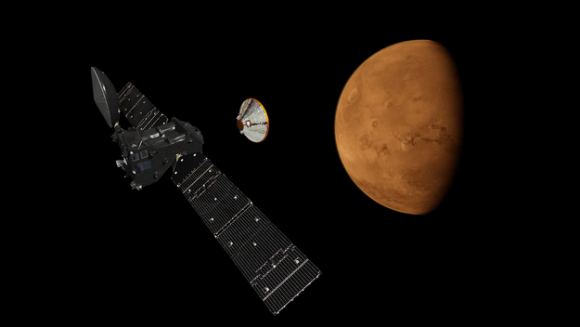
“We aim to fully automate the image production process,” said Nicolas Thomas, the camera’s principal investigator from the University of Bern. “Once we achieve this, we can distribute the data quickly to the science community for analysis.”
A lot of challenges lie ahead, which includes a long period of data collection to bring out the details of rare (or yet to be discovered) trace gases in Mars’ atmosphere. This is necessary since trace gases (as the name would suggest) are present in only very small amounts – i.e. less than 1% of the volume of the planet’s atmosphere. But as Håkan Svedhem – the ESA’s TGO project scientist – indicated, the test image was a good start.
“We are excited to finally be starting collecting data at Mars with this phenomenal spacecraft,” he said. “The test images we have seen so far certainly set the bar high.”
By 2020, the second part of the ExoMars mission is scheduled to launch. This will consist of a Russian surface platform and a European rover landing on the surface in support of a science mission that is expected to last into 2022 or longer. Alongside NASA’s proposed Mars 2020 rover, the Red Planet is due to have several more visitors in the coming years!
Further Reading: ESA

